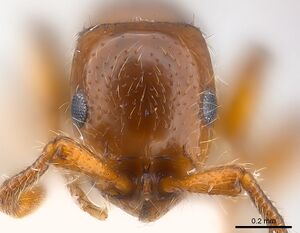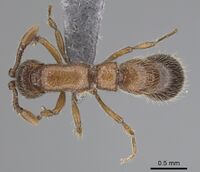Parasyscia rifati
| Parasyscia rifati | |
|---|---|

| |
| Scientific classification | |
| Kingdom: | Animalia |
| Phylum: | Arthropoda |
| Class: | Insecta |
| Order: | Hymenoptera |
| Family: | Formicidae |
| Subfamily: | Dorylinae |
| Genus: | Parasyscia |
| Species: | P. rifati |
| Binomial name | |
| Parasyscia rifati Sharaf & Akbar, 2018 | |
In the Asir Mountains several workers were foraging in moist leaf litter under a large fig tree while material from Asir Province, Abha, Raydah, were collected by pitfall traps. Otherwise, nothing is known of the ecology or biology of the species. (Sharaf et al., 2018)
Identification
Parasyscia rifati can be diagnosed by the combination of the following characters: eyes moderately large with 11–12 ommatidia in the longest row; petiole appears trapezoidal in dorsal view with acute anterior and posterolateral angles; mesosoma, petiole, appendages and first gastral segment yellow or yellow-brown, head and rest of gastral tergites brown.
Parasyscia rifati is morphologically closest to Parasyscia kenyensis from Kenya in terms of colour and body measurements. However, Parasyscia rifati can be easily separated from Parasyscia kenyensis by the larger eyes, with 11–12 ommatidia in the longest row, the shorter scapes that fail to reach posterior margin of eyes, the superficial punctures over body surface, and the shining cephalic surface, whereas Parasyscia kenyensis has smaller eyes, with 1–5 ommatidia in the longest row, longer scapes that surpass posterior margin of eyes, deep punctures over body surface, and dull cephalic surface. Parasyscia rifati is readily distinguished from the Arabian species Parasyscia wittmeri by the following couplet:
- Eyes small with five ommatidia in the longest row (EI 11–18); petiole nearly oval in dorsal view with rounded anterior and posterolateral angles . . . . . Parasyscia wittmeri
- Eyes larger with 11–12 ommatidia in the longest row (EI 15–30); petiole clearly trapezoidal in dorsal view with acute anterior and posterolateral angles . . . . . Parasyscia rifati
Keys including this Species
Distribution
Latitudinal Distribution Pattern
Latitudinal Range: 19.934583° to 18.193633°.
| North Temperate |
North Subtropical |
Tropical | South Subtropical |
South Temperate |
- Source: AntMaps
Distribution based on Regional Taxon Lists
Afrotropical Region: Saudi Arabia (type locality).
Distribution based on AntMaps
Distribution based on AntWeb specimens
Check data from AntWeb
Countries Occupied
| Number of countries occupied by this species based on AntWiki Regional Taxon Lists. In general, fewer countries occupied indicates a narrower range, while more countries indicates a more widespread species. |

|
Estimated Abundance
| Relative abundance based on number of AntMaps records per species (this species within the purple bar). Fewer records (to the left) indicates a less abundant/encountered species while more records (to the right) indicates more abundant/encountered species. |

|
Biology
Castes
Worker
Images from AntWeb
   
| |
| Paratype of Parasyscia rifati. Worker. Specimen code casent0217369. Photographer Erin Prado, uploaded by California Academy of Sciences. | Owned by KSMA. |
Nomenclature
The following information is derived from Barry Bolton's Online Catalogue of the Ants of the World.
- rifati. Parasyscia rifati Sharaf & Akbar, in Sharaf, Akbar & Aldawood, 2018: 216, figs. 1-3, 6-13 (w., ergatoid q.) SAUDI ARABIA.
- Type-material: holotype worker, 11 paratype workers, 1 paratype ergatoid queen.
- Type-locality: holotype Saudi Arabia: Al Bahah Prov., Al Mukhwah, Dhi Ayn Archeological Village, 19.929417°N, 41.441722°E, 741 m., 15.v.2011 (M.R. Sharaf); paratypes; 2 workers with same data, 1 worker with same data but 19.9296°N, 41.4433°E, 18.iv.2010, 5 workers, 1 queen with same data but 19.934583°N, 41.442861°E, 744 m., 20.ix.2011, 1 worker with same data but 19.9296°N, 41.44285°E, 750 m., 20.ix.2011 (B.L. Fisher), 1 worker Saudi Arabia: Asir Prov., Abha, Raydah, 18.193633°N, 42.390333°E, 1772 m., 8.vi.2014 (Al Dhafer), 1 worker Asir Prov., Mahayel Asir, Wadi Al Hilah, 18.502017°N, 42.036983°E, 11.ii.2016 (A. Al Ansi).
- Type-depositories: KSMA (holotype); CASC, KSMA (paratypes).
- Distribution: Saudi Arabia.
Unless otherwise noted the text for the remainder of this section is reported from the publication that includes the original description.
Description
Worker
Holotype. BL 2.85; EL 0.12; HL 0.57; HW 0.45; PH 0.35; PL 0.25; PRW 0.37; PW 0.37; SL 0.32; TL 0.30; WL 0.72. Indices. CI 79; EI 27; SI 71. Paratype. BL 2.50–3.47; EL 0.07–0.17; HL 0.60–0.72; HW 0.47–0.57; PH 0.32–0.47; PL 0.27–0.37; PRW 0.32–0.45; PW 0.35–0.45; SL 0.25–0.45; TL 0.25–0.37; WL 0.70–0.92. Indices: CI 78–89; EI 15–30; SI 49–79 (n = 9).
Head. Distinctly longer than broad in full-face view, with nearly straight posterior margin and feebly convex sides; antennae 11 segments; mandibles with two minute reduced basal denticles; torulo-posttorular complex well developed; scapes when laid back from their insertions fail to reach posterior margin of eyes; funicular segments 2–8 distinctly broader than long; preapical segment nearly as long as broad; apical funicular segment swollen forming a distinct club nearly as long as rest of funicular segments except first segment; eyes of moderate size (EI 15–30) with 11–12 ommatidia in longest row. Mesosoma. Promesonotal and metanotal sutures absent; posterior margin of propodeum feebly concave in dorsal view; propodeum little broader than mesosoma in dorsal view. Petiole. Appears trapezoidal in dorsal view, with nearly straight anterior and posterior margins. Sculpture. Body surface punctate. Pilosity. Torulo-posttorular complex with a single hair; pale suberect hairs abundant over entire body surfaces. Colour. Mesosoma, petiole, legs, antennae and first gastral segment yellow or yellowbrown, head and rest of gastral segments brown.
Queen
Ergatoid: BL 2.92; EL 0.12; HL 0.65; HW 0.52; PH 0.32; PL 0.35; PRW 0.37; PW 0.42; SL 0.40; TL 0.35; WL 0.87. Indices: CI 80; EI 23; SI 77 (n = 1). Head distinctly longer than broad in full-face view, with nearly straight posterior margin and feebly convex sides; antennae 12 segments; mandibles with two minute reduced basal denticles; torulo-posttorular complex well developed; scapes when laid back from their insertions fail to reach posterior margin of eyes; funicular segments 2–8 distinctly broader than long; preapical two segments nearly as long as broad; apical funicular segment swollen forming a distinct club; eyes moderately large (EI 23) with more than 20 ommatidia in longest row; ocelli well developed. Mesosoma, Petiole, Sculpture, Pilosity and Colour matching all characters of worker caste.
Type Material
Holotype. K.S.A.: Al Bahah Province,Al Mukhwah, Dhi Ayn Archeological village,19.929417°N 41.441722°E, 741 m, 15.v.2011, (M.R.Sharaf leg.) (CASENT0823938, King Saud Museum of Arthropods). Paratypes. K.S.A.: Al Bahah Province, Al Mukhwah, Dhi Ayn Archeological village,19.9296°N 41.4433°E, 741 m, 18.iv.2010, (M.R.Sharaf leg.) (1w, CASENT0217369); Al Bahah Province, Al Mukhwah, Dhi Ayn Archeological village,19.934583°N 41.442861°E, 744 m, 20.ix.2011, MRS0022, (M.R. Sharaf leg.) (5 w); same data as the holotype (2 w); Asir Province, Abha, Raydah, 18.193633°N 42.390333°E, 1772 m, 08.vi.2014, (Al Dhafer et al. leg.) (1 w); Asir Province, Mahayel Asir, Wadi Al Hilah, 18.502017°N 42.036983°E,11.ii.2016, (A. Al Ansi leg.) (1 w) all in KSMA; Al Bahah Province, Al Mukhwah, Dhi Ayn Archeological village, 19.9296°N 41.44285°E, 750 m, 20.ix.2011, (B.L. Fisher leg.) (1 w, CASENT0263910, California Academy of Sciences). Paratype pinned queen: Al Bahah Province, Al Mukhwah, Dhi Ayn Archeological village,19.934583°N 41.442861°E, 744 m, 20.ix.2011, MRS0022, (M.R. Sharaf leg.) (1 w, CASENT-0823939, KSMA).
Etymology
Sharaf et al. (2018) - The patronymic name (Parasyscia rifati) has been selected in honour of the late famous Egyptian Qura’an reader Sheikh Muhammad Rifat (1882–1950).
References
- Chen, Z., Liang, C., Du, C. 2022. Revision of Chinese species of the ant genus Parasyscia Emery, 1882 (Hymenoptera: Formicidae: Dorylinae). Zootaxa 5196(3), 301–330 (doi:10.11646/zootaxa.5196.3.1).
- Sharaf, M.R., Akbar, S.A., Aldawood, A.S. 2018. Review of the Arabian rare ant genus Parasyscia Emery, 1882 (Hymenoptera: Formicidae) with description of a new species from the Asir Mountains, Saudi Arabia. African Entomology 26(1): 215–223 (doi:10.4001/003.026.0215).

